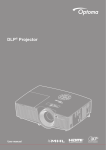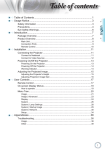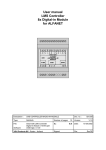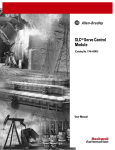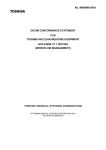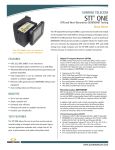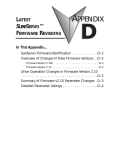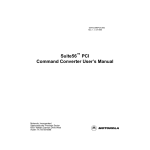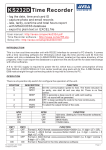Download Appendix A - AutomationDirect
Transcript
SureSERVO™ QUICK START GUIDE APPENDIX A B In This Appendix ... Quick Start for SureServo™ Drives . . . . . . . . . . . . .A–2 Spin the Motor . . . . . . . . . . . . . . . . . . . . . . . . . . . . . . . . . . . . . .A–2 Position Mode Quick Start (Pt & Pr) . . . . . . . . . . . . . . . . . . . . . .A–4 Velocity Mode Quick Start (V & Vz) . . . . . . . . . . . . . . . . . . . . . .A–8 Torque Mode Quick Start (T & Tz) . . . . . . . . . . . . . . . . . . . . . .A–10 Tuning Quick Start for SureServo™ Drives . . . . . .A–12 Tuning Overview . . . . . . . . . . . . . . . . . . . . . . . . . . . . . . . . . . . .A–12 PDFF Adaptive Auto-Tune Mode Adjustments . . . . . . . . . . . . . .A–12 Appendix A: SureServo™ Quick Start Guide Quick Start for SureServo™ Drives This guide allows you to get your SureServo motor and drive up and running as quickly as possible. This is not a substitute for reviewing the entire manual. You will need to familiarize yourself with the complete feature set of the drive. This quick start guide will serve as initial setup only. WARNING: To prevent serious injury or damage to equipment, always start any new servo setup with the motor shaft disconnected from the load. The quick start will bypass mechanical overtravels and overrides. DISCONNECT THE LOAD. Always wire an E-Stop circuit into the power feed for the drive. Always drop the main incoming power for E-Stop conditions; control power can remain ON. The Quick Start Guide is divided into four sections: • Spin the Motor • Position Mode Quick Start • Velocity Mode Quick Start • Torque Mode Quick Start Spin the Motor The first thing you want to do with the SureServo is spin the motor. This section will verify that all the components and cabling are working properly by allowing you to JOG the motor. These simple steps will get your SureServo system up and moving: 1. Disconnect the motor from any load. Connect the motor cables to the motor and drive. Make sure to connect the motor ground. Do not connect CN1, the I/O connector. 2. Wire the appropriate fusing and an E-stop contactor to the drive. See Chapter 2 for wiring information. Make sure to connect an external ground to the drive (large, multi-strand conductors are recommended). Verify that the E-Stop contactor functions properly before plugging the power connector into the drive. 3. Power up the drive. There will be errors. ALE 14 and ALE 15 are Alarm Errors for the Overtravel Limit switches (see Chapter 7 for explanation; they are NC by default). 4. Set Parameter P2-08 to 10. This will reset the drive to factory defaults. Press MODE, then press NEXT until P2-00 appears. Press ARROW-UP until P2-08 appears. Press ENTER. Press ARROW-UP until you enter a value of 10. Press ENTER to accept. See Chapter 3 for additional keypad help. If using SureServo Pro software (recommended), the drive communication defaults to 19.2k, 8, 0, 1, MODBUS RTU, Node 1 (this is the software default, too). Note: For each parameter change in the software, you must download all settings to the drive. A–2 P2-08 Password (and Factory Default) 10 Reset Drive to Factory Defaults SureServo™ AC Servo Systems User Manual 2nd Ed, Rev B 08/2011 Appendix A: SureServo™ Quick Start Guide 5. Set the appropriate motor code in P1-31. Refer to the “Servo Drive Parameters” chapter for details. P1-31 Motor Code 10 = 100 W 21 = 1 kW (low inertia) 11 = 200 W 22 = 1 kW (medium inertia) 12 = 400 W 30 = 2 kW 20 = 750 W 31 = 3 kW ** For SureServo drives with firmware version 2.103, execute Step 6. For previous firmware versions, skip Step 6 and proceed to Step 7. 6. (for firmware v2.103 only) Disable Digital Input 8 (DI8) by changing the value in P2-17 to zero. Refer to “Servo Drive Parameters” chapter for details. 7. Cycle Power to the Drive. 8. Set Parameter P2-30 to 1. This temporarily overrides Servo Enable, CW Limit, and CCW Limit. Make sure the motor is disconnected from the load. P2-30 Auxiliary Function 1 Force Servo to be Enable (regardless of input status) 9. Jog the motor. For Keypad operation: Go to P4-05, JOG Operation. Press ENTER. This is the JOG speed setpoint. Adjust this to the desired jogging speed. (NEXT will move the cursor to the left.) Press ENTER. The LED display will show "JOG". Press the UP-ARROW or DOWN-ARROW to Jog the motor forward or reverse. Press MODE to exit the JOG operation. P4-05 JOG Operation 100 Jog the motor at 100 rpm when the JOG signal is active If the motor run, stop, and direction behavior is not as expected, then recheck the motor power wiring at the drive U, V, W, and ground terminals. (Refer to Chapter 2 for wire color and terminal connection information.) 10. Cycle Control Power to the drive. This will reset P2-30, re-enabling the Servo Enable, CW Limit, and CCW Limit inputs. 2nd Ed, Rev B 08/2011 SureServo™ AC Servo Systems User Manual A–3 Appendix A: SureServo™ Quick Start Guide Position Mode Quick Start (Pt & Pr) This section explains the basic procedures necessary to control the SureServo drive in Position Mode; both pulse input (Pt) and internal positioning (Pr). In Pt mode, positioning commands come from high-speed pulse trains from the terminals. In Pr mode, positioning commands are held in internal registers. Pt Mode - High-Speed Pulse Input (Position - terminals) 1. Spin the Motor. Follow the instructions in the previous section to verify that the motor and drive are functioning properly. Cycle power to the drive. At this point, power, fusing, and an E-stop contactor should all be wired appropriately (see Chapter 2 for wiring information). The motor code in P1-31 should be set to the correct motor type. 2. Set the Pulse Type and Control Mode. P1-00 selects the type of pulse stream that will come into the drive. P1-01 selects the actual control mode: 0000 will result in Pt mode with the motor spinning CCW as forward. The second MSB selects direction. Note: 0101 will result in Pt mode with motor spinning CW as forward. P1-00 External Input Pulse Type (See Chapter 2 and Appendix C for encoder wiring details.) 000 Quadrature Input - A, /A, B, /B (typical encoder input signals) 001 CW + CCW pulse input 002 Pulse + Direction See the “Servo Drive Parameters” chapter for more information regarding Positive vs. Negative signals, forward/reverse, etc. P1-01 Control Mode and Output Direction 0000 Drive accepts Position Control via external pulse inputs with CW direction. 0100 Drive accepts Position Control via external pulse inputs with CCW direction. See the “Servo Drive Parameters” chapter for more information regarding changing directions, dual modes, etc. 3. Configure the Digital Inputs. Select which DI (digital inputs) your system will require. See P2-10 through P2-17 to select the correct configuration (these parameters set NO/NC and the functionality of each input). A minimum configuration should contain at least Servo Enable, Alarm Reset, Fault Stop, and CW/CCW limits (if your system has overtravels). Once these settings are configured, cycle power to the drive for them to take effect. The motor should now follow the incoming pulses when the servo is enabled, so when you turn the encoder shaft the servo motor will follow the movement. P2-10 Through P2-17 Digital Input Definition P2-10 101 DI1 = Servo Enable Normally Open P2-14 102 DI5 = Alarm Reset Normally Open P2-15 022 P2-16 023 P2-17 121 DI6 = Reverse Overtravel (set to 000 to disable this input) DI7 = Forward Overtravel (set to 000 to disable this input) Normally Closed Normally Closed DI8 = Fault Stop Normally Open See the “Servo Drive Parameters” chapter for more information regarding normally open vs. normally closed, additional functions, etc. A–4 SureServo™ AC Servo Systems User Manual 2nd Ed, Rev B 08/2011 Appendix A: SureServo™ Quick Start Guide 4. Gearing. Electronic Gearing can be set in P1-44 (Numerator) and P1-45 (Denominator). Default setting is 1/1 (1 incoming pulse = motor movement of 1 count). Note: One revolution of a 2500ppr quadrature encoder (A, /A, B, /B) will actually cause the motor to rotate one entire revolution since the SureServo treats each transitional edge as an input (2500ppr x 4 = 10,000 = 1 motor rev). Pr Mode - Internal Indexing (Position - registers) 1. Spin the Motor. Follow the instructions in the previous section to verify that the motor and drive are functioning properly. Cycle power to the drive. At this point, power, fusing, and an E-stop contactor should all be wired appropriately according to Chapter 2. The motor code in P1-31 should be set to the correct motor type. 2. Set the Control Mode. P1-01 selects the actual control mode: 0001 will result in Pr mode with the motor spinning CCW as forward. The second MSB selects direction. Note: 0101 will result in Pr mode with motor spinning CW as forward. P1-01 Control Mode and Output Direction 0001 Drive is in Internal Indexing Mode. Setpoints are internal registers selected via Digital Inputs with CCW direction. 0101 Drive is in Internal Indexing Mode. Setpoints are internal registers selected via Digital Inputs with CW direction. See the “Servo Drive Parameters” chapter for more information regarding changing directions, dual modes, etc. 3. Configure the Basic Digital Inputs. Select which digital inputs your system will require. See P2-10 through P2-17 to select the correct configuration (these parameters set NO/NC and the functionality of each input). A minimum configuration should contain at least Servo Enable, Alarm Reset, and CW/CCW limits (if your system has overtravel limits). P2-10 Through P2-17 Digital Input Definition P2-10 101 DI1 = Servos On Normally Open P2-14 102 DI5 = Alarm Reset Normally Open P2-15 022 DI6 = Reverse Overtravel (set to 000 to disable this input) Normally Closed P2-16 023 DI7 = Forward Overtravel (set to 000 to disable this input) Normally Closed P2-17 121 DI8 = Fault Stop Normally Open See the “Servo Drive Parameters” chapter for more information regarding normally open vs. normally closed, additional functions, etc. 2nd Ed, Rev B 08/2011 SureServo™ AC Servo Systems User Manual A–5 Appendix A: SureServo™ Quick Start Guide 4. Configure the position selection. The drive can be configured to select the internal Position setpoint by 3 digital inputs; POS0, POS1, and POS2. Any of the digital inputs can be set as POS0 (code 11), POS1 (code 12), or POS2 (code 13) in P2-10 through P2-17. By configuring all 3 inputs, all of the 8 internal presets can be selected via external signals. To save digital inputs for other uses, not all POSx’s have to be configured. If only two setpoints are needed (for example: the motor needs to move and then return), then only one POSx needs to be configured. Configuring only input POS2 (POS0 and POS1 not assigned) would allow the selection of Position 1 and Position 5. Or, if you will be writing to the Modbus address of Position 0 to change the setpoint after each index, no digital inputs have to be used at all. Disabling the inputs causes them to act as if they were inactive, so when all POSx inputs are disabled = Position 1. One input, however, should be selected as the Command Trigger (code 08). When pulsed, this input will cause the drive to move to the selected setpoint position. P2-10 Through P2-17 P2-11 111 P2-12 112 P2-13 108 Digital Input Definition DI2 = POS0 (bit 0 of the binary code to select internal setpoints) DI3 = POS1 (bit 1 of the binary code to select internal setpoints) Normally Open Normally Open DI4 = Command Trigger Normally Open Defining POS0 and POS1 will allow selection of Positions 1-4. See the “Servo Drive Parameters” chapter for more information regarding normally open vs. normally closed, additional functions, etc. 5. Configure the Position Setpoints. Parameter P1-33 selects Incremental or Absolute mode. Enter a value of "0" for Absolute Mode or enter "1" for Incremental mode. Parameters (P1-15 through P1-30) determine the setpoints of Positions 1 through 8. Each setpoint has 2 parts; motor revolutions and pulses. One motor revolution consists of 10,000 counts. So, to move the motor Incrementally 3-½ turns (or to Absolute position 3-½ revs from home), place a 3 in the first position parameter and a 5000 into the second. P1-33 Position Control Mode Absolute Mode - Each index will cause the motor to move to (or stay at) an absolute position. Incremental Mode - Each index will cause the motor to advance by the 1 commanded amount. See the “Servo Drive Parameters” chapter for more information regarding different modes, resolution, etc. 0 P1-15 Through P1-30 Position Setpoints P1-15 3 Index #1 - Motor Revolutions P1-16 5000 Index #1 - Motor Counts (out of 10,000 counts per 1 revolution. The above settings will cause the motor to move 3-1/2 revolutions when POSx inputs are OFF and the Command Trigger is pulsed. See the “Servo Drive Parameters” chapter for more information regarding different modes, resolution, etc. A–6 SureServo™ AC Servo Systems User Manual 2nd Ed, Rev B 08/2011 Appendix A: SureServo™ Quick Start Guide 6. Configure Accel, Decel, and Speeds. P1-34 and P1-35 are the Acceleration and Deceleration parameters (accel time in ms from 0 rpm to P1-55 max velocity limit, and decel time from max velocity limit to 0 rpm). P1-36, Accel/Decel SCurve Time (ms), must be set to a non-zero number for accel and decel to take effect. Without adjusting the 3 acc/dec parameters, the drive may fault when first moved. Parameters P2-36 through P2-43 are the 8 speed settings that correspond to the 8 position setpoints. Their default is 1000 rpm. Once all of the above parameters are configured, cycle power to the drive. The drive should now respond to the Command Trigger Input. P1-34 Through P1-36 Acceleration, Deceleration, and S-Curve P1-34 200 Acceleration Time (in ms) P1-35 200 Deceleration Time (in ms) P1-36 50 S-Curve Time (in ms) - This setting must be non-zero for Acceleration/Deceleration to take effect. See the “Servo Drive Parameters” chapter for more information regarding ranges, etc. P2-36 Through P2-43 P2-36 1000 Index Speeds Speed for Index #1 (in rpm). All speed settings are 1000 rpm default. See the “Servo Drive Parameters” chapter for more information regarding ranges, etc. POS2 POS1 POS0 Position Setpoint Velocity 0 0 0 Position 1 = P1-15, P1-16 Velocity 1 = P2-36 0 0 1 Position 2 = P1-17, P1-18 Velocity 2 = P2-37 0 1 0 Position 3 = P1-19, P1-20 Velocity 3 = P2-38 0 1 1 Position 4 = P1-21, P1-22 Velocity 4 = P2-39 1 0 0 Position 5 = P1-23, P1-24 Velocity 5 = P2-40 1 0 1 Position 6 = P1-25, P1-26 Velocity 6 = P2-41 1 1 0 Position 7 = P1-27, P1-28 Velocity 7 = P2-42 1 1 1 Position 8 = P1-29, P1-30 Velocity 8 = P2-43 NOTE: If a POSx selector is not defined, it has a value of 0 (off). 2nd Ed, Rev B 08/2011 SureServo™ AC Servo Systems User Manual A–7 Appendix A: SureServo™ Quick Start Guide Velocity Mode Quick Start (V & Vz) 1. Spin the Motor. Follow the instructions in the previous section to verify that the motor and drive are functioning properly. Cycle power to the drive. At this point, power, fusing, and fault stop should all be wired appropriately; see Chapter 2 for wiring information. The P1-31 motor code should be set to the correct motor type. 2. Set the Control Mode. P1-01 selects the actual control mode; 0002 will result in analog/preset Velocity mode with the motor spinning CCW as forward. (The second MSB selects direction.) Vz Mode (internal velocity presets only) can be selected by entering 0004. P1-01 Control Mode and Output Direction xx02 Drive is in Velocity Mode V. Drive Speed is determined via analog signal or by internal presets. xx04 Drive is in Velocity Mode Vz. Speed is determined by internal presets only. See the “Servo Drive Parameters” chapter for more information regarding changing directions, dual modes, etc. 3. Configure the Digital Inputs. Select which DI (digital inputs) your system will require. See P2-10 through P2-17 to select the correct configuration (these parameters set NO/NC and the functionality of each input). A minimum configuration should contain at least Servo Enable, Alarm Reset, Fault Stop, and CW/CCW limits (if your system has overtravels). If you want to be able to select Preset Speeds, you must also configure inputs for SPD0 and SPD1 (to be able to select the speed setpoints through binary code). Once these settings are configured, cycle power to the drive for them to take effect. P2-10 Through P2-17 Digital Input Definition P2-10 101 DI1 = Servo Enable Normally Open P2-11 114 DI2 = SPD0 (bit 0 of the binary code to select the desired speed) Normally Open P2-12 115 DI3 = SPD1 (bit 1 of the binary code to select the desired speed) Normally Open P2-14 102 DI5 = Alarm Reset Normally Open P2-15 022 DI6 = Reverse Overtravel (set to 000 to disable this input) Normally Closed P2-16 023 DI7 = Forward Overtravel (set to 000 to disable this input) Normally Closed P2-17 121 DI8 = Fault Stop Normally Open See the “Servo Drive Parameters” chapter for more information regarding normally open vs. normally closed, additional functions, etc. A–8 SureServo™ AC Servo Systems User Manual 2nd Ed, Rev B 08/2011 Appendix A: SureServo™ Quick Start Guide 4. Configure the Velocity Setpoints (if using Preset Velocities). P1-09, P1-10, and P1-11 are the three Velocity Setpoints that can be selected via the digital inputs. When the digital inputs are both inactive, the speed command will be the +/-10V analog input command if in V mode. If the drive is in Vz mode, the command speed will be absolute zero (to allow for a "no drift" command). P1-09 Through P1-11 Internal Speed Setpoints P1-09 100 1st Velocity Command (SPD1 = OFF; SPD0 = ON) P1-10 200 2nd Velocity Command (SPD1 = ON; SPD0 = OFF) P1-11 300 3rd Velocity Command (SPD1 = ON; SPD0 = ON) If both SPD0 and SPD1 are OFF, the drive will follow the analog input. See the “Servo Drive Parameters” chapter for more information regarding normally open vs. normally closed, additional functions, etc. 5. Configure Accel, Decel, and Speeds. P1-34 and P1-35 are the Acceleration and Deceleration parameters (accel time in ms from 0 rpm to P1-55 max velocity limit, and decel time from max velocity limit to 0 rpm). P1-36, Accel/Decel SCurve Time (ms), must be set to a non-zero number for accel and decel to take effect. Without adjusting the 3 acc/dec parameters, the drive may fault when first moved. P1-34 Through P1-36 Acceleration, Deceleration, and S-Curve P1-34 200 Acceleration Time (in ms) P1-35 200 Deceleration Time (in ms) P1-36 50 S-Curve Time (in ms) - This setting must be non-zero for Acceleration/Deceleration to take effect. See the “Servo Drive Parameters” chapter for more information regarding ranges, etc. 6. Enable the Drive and Apply the Velocity Command. If no errors exist, the drive should now follow the commanded velocity when enabled. With the Digital Inputs for Velocity Command Select Inputs SPD0 and SPD1 both inactive (or undefined), the drive should respond to an analog input signal if configured for V mode (if configured for Vz mode, both inputs inactive = zero speed). For both V and Vz modes, the drive should move at the preset speeds when Velocity Command Select Inputs SPD0 and SPD1 are set appropriately. SPD1 SPD0 Velocity Setpoint 0 0 Vz Mode = 0 (zero) V Mode = Analog signal 0 1 1st Velocity Command = P1-09 1 0 2nd Velocity Command = P1-10 1 1 3rd Velocity Command = P1-11 NOTE: If SPD1 or SPD0 are not defined, their value is 0 (off). 2nd Ed, Rev B 08/2011 SureServo™ AC Servo Systems User Manual A–9 Appendix A: SureServo™ Quick Start Guide Torque Mode Quick Start (T & Tz) 1. Spin the Motor. Follow the instructions in the previous section to verify that the motor and drive are functioning properly. Cycle power to the drive. At this point, power, fusing, and E-stop should all be wired appropriately. The motor code in P1-31 should be set to the correct motor type. 2. Set the Control Mode. P1-01 selects the actual control mode; 0003 will result in analog/preset Torque mode with the motor spinning CCW as forward. (The second MSB selects direction.) Tz Mode (internal torque presets only) can be selected by entering 0005. P1-01 Control Mode and Output Direction xx03 Drive is in Torque Mode T. Drive torque is determined via analog signal or by internal presets. xx05 Drive is in Torque Mode Tz. Drive torque is determined by internal presets only. See the “Servo Drive Parameters” chapter for more information regarding changing directions, dual modes, etc. 3. Configure the Digital Inputs. Select which DI (digital inputs) your system will require. See P2-10 through P2-17 to select the correct configuration (these parameters set NO/NC and the functionality of each input). A minimum configuration should contain at least Servo Enable, Alarm Reset, Fault Stop, and CW/CCW limits (if your system has overtravels). If you want to be able to select Preset Torques, you must also configure inputs for Torque Command Inputs TCM0 and TCM1 (to be able to select the Torque setpoints through binary code). Once these settings are configured, cycle power to the drive for them to take effect. P2-10 Through P2-17 Digital Input Definition P2-10 101 DI1 = Servo Enable Normally Open P2-11 116 DI2 = TCM0 (bit 0 of the binary code to select the desired torque) Normally Open P2-12 117 DI3 = TCM1 (bit 1 of the binary code to select the desired torque) Normally Open P2-14 102 DI5 = Alarm Reset Normally Open P2-15 022 DI6 = Reverse Overtravel (set to 000 to disable this input) Normally Closed P2-16 023 DI7 = Forward Overtravel (set to 000 to disable this input) Normally Closed P2-17 121 DI8 = Fault Stop Normally Open See the “Servo Drive Parameters” chapter for more information regarding normally open vs. normally closed, additional functions, etc. A–10 SureServo™ AC Servo Systems User Manual 2nd Ed, Rev B 08/2011 Appendix A: SureServo™ Quick Start Guide 4. Configure the Torque Setpoints and Speed Limits. P1-12, P1-13, and P1-14 are the three Torque Setpoints that can be selected via the digital inputs. When the digital inputs are both inactive, the Torque command will be the +/-10V analog input command if in T mode. If the drive is in Tz mode, the command torque will be an absolute zero. P1-02, P1-09, P1-10, and P1-11 set the speed limits that will be used in Torque mode. P1-02 enables an analog Velocity limit when using the analog Torques signal. The other three parameters are velocity limits that correspond to Torque Presets 1, 2, and 3. P1-12 Through P1-14 Internal Torque Setpoints P1-12 30 1st Torque Command (TCM1 = OFF; TCM0 = ON) P1-13 40 2nd Torque Command (TCM1 = ON; TCM0 = OFF) P1-14 50 3rd Torque Command (TCM1 = ON; TCM0 = ON) If both TCM0 and TCM1 are OFF, the drive will follow the analog input. See the “Servo Drive Parameters” chapter for more information regarding normally open vs. normally closed, additional functions, etc. 5. Configure Accel, Decel, and Speeds. P1-34 and P1-35 are the Acceleration and Deceleration parameters (accel time in ms from 0 rpm to P1-55 max velocity limit, and decel time from max velocity limit to 0 rpm). P1-36, Accel/Decel SCurve Time (ms), must be set to a non-zero number for accel and decel to take affect. Without adjusting the 3 acc/dec parameters, the drive may fault when first moved. P1-34 Through P1-36 Acceleration, Deceleration, and S-Curve P1-34 200 Acceleration Time (in ms) P1-35 200 Deceleration Time (in ms) P1-36 50 S-Curve Time (in ms) - This setting must be non-zero to Acceleration/Deceleration to take effect. See the “Servo Drive Parameters” chapter for more information regarding ranges, etc. 6. Enable the Drive and Apply the Torque Command. If no errors exist, the drive should now follow the commanded Torque when enabled. With the Digital Inputs for Torque Command Select Inputs TCM0 and TCM1 both inactive (or undefined), the drive should respond to an analog input signal if configured for T mode (if configured for Tz mode, both inputs inactive = zero Torque). For both T and Tz modes, the drive should move to the preset speeds when Torque Command Select Inputs TCM0 and TCM1 are set appropriately. TCM1 TCM0 Torque Level 0 0 Tz Mode = 0 (zero) T Mode = Analog signal 0 1 1st Torque Command = P1-12 1 0 2nd Torque Command = P1-13 1 1 3rd Torque Command = P1-14 NOTE: If TCM1 or TCM0 are not defined, their value is 0 (off). 2nd Ed, Rev B 08/2011 SureServo™ AC Servo Systems User Manual A–11 Appendix A: SureServo™ Quick Start Guide Tuning Quick Start for SureServo™ Drives Tuning Overview After installing the SureServo system and testing its functionality (wiring, communication, motion, etc.), you may decide that the default tuning selection is either too responsive or not responsive enough for your application. This Quick Start Guide section will walk you through the very basic steps to adjust the drive tuning using the “PDFF Adaptive Auto-Tune Mode”. Other tuning modes are explained in the “Control Modes of Operation and Tuning” Chapter of this manual. The SureServo drive has three available modes of tuning: Manual, Easy, and Auto. (The Auto tuning mode includes two sub-modes: Adaptive Auto and Fixed Auto.) Manual Tuning Mode requires an in-depth knowledge of tuning parameters and the physical characteristics of the system, and it will not be covered in this Quick Start Guide. Easy-Tune Mode presets many of the tuning parameters and is useful when the system load (and inertia) changes significantly. Easy-Tune is helpful if the inertia mismatch ratio is not known. After Easy-Tuning, it may still be necessary to switch to a fixed mismatch ratio tuning method to fine-tune the system. Auto-Tune Mode is available in Adaptive and Fixed sub-modes. In Adaptive Auto-Tune Mode, the drive constantly monitors the load and adjusts the tuning parameters. In Fixed Auto-Tune Mode, the inertia and mismatch are known and entered by the user. Refer to the “Control Modes of Operation and Tuning” chapter of this manual for more details and explanation of tuning the servo in all of the different modes, and how to select which mode is best for your application. PDFF Adaptive Auto-Tune Mode Adjustments The PDFF Adaptive Auto-Tune Mode (P2-32 = 4) constantly monitors the system load and inertia, and continually updates the tuning parameters. Besides P2-32, the only additional parameter that needs to be set by the user is P2-31, which determines the overall responsiveness of the servo system. The actual load being controlled must be connected to the motor before performing tuning. For Keypad Tuning 1) Set P2-32 to “4” (PDFF Adaptive Auto-Tune Mode). The drive must not be enabled for this change to occur. 2) Enable the drive. 3) Write down the current value of P2-31 (response level). The value will be a twodigit number. Each digit is independent of the other, and each has a range of 0 to F (hex). 4) Adjust the left (leading) digit to change the responsiveness of the servo system. Increase this number to make the system more responsive, or decrease the number to make the system less responsive (more “sluggish”). If you increase the number too much, the system will become unstable and begin to vibrate. If you decrease the number too much, the system will not respond quickly enough to command signals. If you cannot stabilize the drive using this method, try switching to a tuning mode with a fixed mismatch ratio such as P2-32 = 3 or 5. Adjust the parameters for that mode per Table 6-1 of the “Control Modes of Operation and Tuning” chapter. In the fixed mode, set P2-31 to the value the drive had previously calculated in the PDFF Adaptive AutoTune Mode. A–12 SureServo™ AC Servo Systems User Manual 2nd Ed, Rev B 08/2011 Appendix A: SureServo™ Quick Start Guide For SureServo Pro Tuning 1) Open the SureServo Pro software and “Connect” to the drive. The software has the same default communication settings as does the drive. Refer to the 3-xx Communication Parameters section of the “Servo Drive Parameters” chapter for more information about communications parameters. 2) Under “Utilities”, select “Tuning Screen” as shown below in the SureServo Pro screen capture. 3) Confirm that the Tuning Mode is set for “4: PDFF Auto-Tuning (Continuous Adjustment)”. If not, disable the drive, change the setting in the software, and then press “Set”. (This setting is cannot be changed when the drive is enabled.) 4) Enable the drive. 5) Choose the desired “Response Level” of the drive. Increase the value to make the system more responsive, or decrease the value to make the system less responsive. If you increase the value too much, the system will become unstable and begin to vibrate. If you decrease the value too much, the system will not respond quickly enough to command signals. 6) Press “Click To Send New Settings To Drive”. The new settings take effect immediately. No other settings have to be changed. 7) If the response of the SureServo is not satisfactory, refer to the “Control Modes of Operation and Tuning” chapter for other tuning modes and more specific tuning instructions. 2nd Ed, Rev B 08/2011 SureServo™ AC Servo Systems User Manual A–13 Appendix A: SureServo™ Quick Start Guide BLANK PAGE A–14 SureServo™ AC Servo Systems User Manual 2nd Ed, Rev B 08/2011














